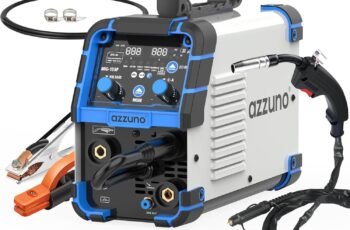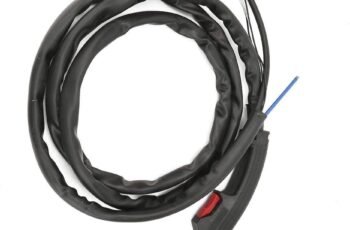Ad Blocker Detected
Our website is made possible by displaying online advertisements to our visitors. Please consider supporting us by disabling your ad blocker.
Choosing the right MIG welding wire for your machine is crucial for achieving strong, clean welds. You’ll need to consider factors like the base material, thickness, and specific application needs. Whether you’re working with carbon steel or stainless, selecting the appropriate wire type and diameter makes all the difference. Additionally, the right shielding gas ensures optimal performance. Ready to explore the intricacies of wire selection and enhance your welding results?
Understanding Material Types and Their Requirements
When choosing MIG welding wire, understanding the material types and their requirements is crucial to achieving optimal results. For carbon steel, ER70S-6 wire is your go-to for dealing with surface contaminants, especially when using argon/CO2 blends. If you’re working on high-tensile applications, opt for ER70S-7 due to its enhanced manganese content. Stainless steel wires like ER308L are perfect for food-grade projects, offering excellent corrosion resistance with argon shielding. The AWS classification system helps ensure that the mechanical and chemical properties of MIG wires are consistent globally. When dealing with aluminum, ER4043 and ER5356 cover most needs, but ensure you’re using pure argon to maintain weld quality. Flux-cored wires are versatile; dual-shield types suit contaminated steel, while gasless versions are great outdoors.
Selecting the Appropriate Wire Gauge
Choosing the right MIG welding wire involves not only understanding material types but also selecting the appropriate wire gauge for your specific project. The gauge impacts your welding performance significantly. For thin materials like automotive panels, use a 0.023″ wire. General steel welding benefits from a 0.030″ wire, while 0.035″ handles thicker steel structures. If you’re tackling industrial applications, a 0.045″ wire is ideal, and for heavy structural work, go with 0.052″. Consider joint configurations too—smaller wires suit lap joints, while bigger ones fill butt joints effectively. Different metals require specific wire types, such as ER308L for stainless steel, ensuring you achieve optimal results. Don’t forget welding positions; vertical and overhead are best with smaller gauges to control droop, whereas flat positions accommodate larger wires for better deposition rates. Choose wisely for success.
Aligning Wire Diameter With Material Thickness
Understanding the relationship between wire diameter and material thickness is crucial to successful MIG welding. Thin sheets, like those at 0.024″, benefit from 0.023″-0.030″ wires to prevent burn-through. Medium gauge materials, within the 20-16 range, require 0.030″-0.045″ wires for adequate penetration. For thicker materials, such as 1/4″ and above, 0.035″-0.045″ wires are necessary, often needing multi-pass welding. Steel over 5.0mm demands 0.9-1.2mm wires or multiple passes. Remember, wire diameter affects amperage—thicker wires mean higher current requirements. Using smaller wires allows lower amps, ideal for thin metals, while larger wires accommodate higher amps for deep penetration. Always consider your machine’s amp capacity and maintain proper stick-out to control heat input effectively. Additionally, choosing the right wire size is essential to ensure strong and reliable welds, as it helps in matching the diameter with the metal thickness for optimal performance.
Decoding AWS Classifications
Decoding AWS classifications is essential for selecting the right MIG welding wire, even though it might seem complex at first. Start with the prefix “ER” for dual-purpose Electrode/Rod applications. The number following it, like “70” in ER70S-6, indicates the tensile strength in PSI, crucial for matching your base material’s strength. Next, identify the wire type: “S” for solid, “T” for flux-cored, and “C” for metal-cored, each with distinct benefits. Pay attention to the numeral designators, such as “6” in ER70S-6, which hints at shielding gas compatibility (commonly 75% Argon/25% CO2) and chemical composition, specifically manganese and silicon levels for cleaner welds. Understanding these elements ensures you choose a wire that meets your welding needs effectively. This classification system also helps in standardizing welding wire identification, making it easier for welders to select the appropriate wire for their specific projects.
Choosing Specialized Alloys for Unique Applications
When faced with unique welding applications, selecting the right specialized alloy wire becomes crucial. You need to match the wire with your project’s demands to ensure performance and durability. For electrical components or heat exchangers, consider the 1000 Series aluminum for its exceptional conductivity. If you’re working on automotive parts, the 3000 Series offers strength and ductility, while the 5000 Series excels in marine applications due to its corrosion resistance. The 6000 Series, with its magnesium and silicon composition, is ideal for aerospace applications due to its strength and weldability. In aerospace, the 6000 Series and ER5356 provide the necessary strength and durability. For stainless steel needs, ER308L is perfect for food-grade environments, while E308LFC-O allows gasless welding in high-heat areas. Always align your wire choice with base metal compatibility and industry standards for optimal results.
Evaluating Gas Types and Shielding Needs
As you finalize the choice of specialized alloys for your welding project, it’s also important to focus on the role of shielding gases in MIG welding.
CO₂ offers deep penetration but causes high spatter, making it suitable for mild steel. For a cleaner finish, the Argon-CO₂ mix (75/25) balances penetration and reduces spatter.
Pure Argon is perfect for aluminum and thin materials due to its stable arc and low spatter. When tackling thick materials, consider adding Helium for enhanced heat input.
Stainless steel benefits from an Argon-Oxygen mix, improving weld pool fluidity.
Keep cost in mind; CO₂ is budget-friendly, while pure Argon is pricier. Ensure your equipment matches your gas choice for optimal results.
Considerations for Aluminum Welding
Understanding aluminum welding requires a focus on selecting the right wire type and alloy compatibility.
For most applications, ER5356 aluminum MIG wire is your go-to choice due to its 5% magnesium content, enhancing weldability, corrosion resistance, and shear strength. It’s perfect for 5XXX series alloys and versatile enough for 1XXX, 6XXX, and 7XXX. Use it for structural tasks like truck frames and marine hardware, especially where saltwater exposure is a concern.
However, avoid it for high-temperature scenarios, as magnesium isn’t suitable there. Keep in mind that ER5356 provides excellent weld penetration and strength, even with thick materials, but mightn’t yield the cleanest appearance.
Ensure you use pure argon gas and the correct settings for optimal results.
Addressing Challenges of Stainless Steel Welding
Although welding stainless steel presents unique challenges, selecting the right wire can significantly enhance your results.
Start by matching the material grade with the appropriate wire. For common grades like 301, 302, or 304, choose ER308L to leverage its ideal Cr/Ni balance.
When dealing with 316-series stainless, opt for 316L/316LSi to boost resistance against chloride corrosion, crucial for marine settings.
Use 309L/309LSi wires for joining stainless to carbon steel, effectively preventing galvanic corrosion.
If high temperatures are involved, 321-grade wires offer stability up to 1500°F.
Remember to differentiate between “L” and “LSi” grades, as silicon in LSi improves weld pool fluidity, ensuring smoother results without sacrificing corrosion resistance.
Proper wire choice tackles stainless steel’s specific welding hurdles efficiently.
Techniques for Welding Thick Materials
When tackling thick materials in welding, proper technique is crucial to ensure strong, reliable joints. Start by beveling edges and grinding workpieces to create tight-fitting joints. Preheat the base metal to 150–300°F for better penetration and less thermal stress.
Use a vertical up technique for thicknesses ≥¼ inch, adjusting the gun angle to 5–15° below perpendicular. Employ slight weaving motions in multi-pass applications to control the weld puddle. Choose thicker filler wire, like 0.045″, and an argon-rich shielding gas to enhance penetration.
Increase amperage and voltage proportionally to the material’s thickness. For materials over 3/8 inch, use multi-pass techniques with interpass cleaning. Alternate pass directions and allow cooling between passes to prevent distortion and stress.
Conclusion
When choosing MIG welding wire, focus on matching the wire type to your base material, like ER70S-6 for carbon steel or ER308L for stainless. Consider the material thickness to select the right wire diameter, ensuring it pairs well with your shielding gas, whether it’s CO₂ or an argon blend. Don’t forget to understand AWS classifications and choose specialized alloys if needed. By paying attention to these details, you’ll achieve optimal weld quality and performance for any project.



